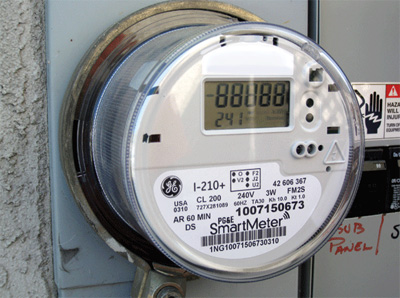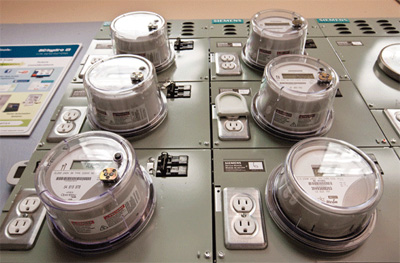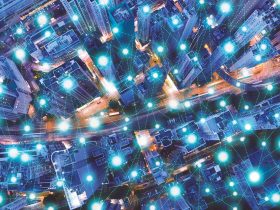The term smart meter is becoming much more common around the country. These new digital meters for recording electricity use are replacing the traditional analog meters that homes and businesses have used since the early 20th century.
A new survey by the Institute for Electric Efficiency (IEE) shows that as of September 2011, electric utilities have installed 27 million of the new smart meters. This equals more than 22 percent of all U.S. households. By 2015, it is projected that approximately 65 million smart meters will be installed, representing 54 percent of all homes in the country.
Like their predecessors, smart meters are a technology for measuring how much electricity an electric utility customer has used over a given amount of time. But instead of waiting to be manually read once a month, as most meters are today, a smart meter can automatically record electricity use every hour or even on demand.
Smart meters also include the capability for creating a two-way communication link between a utility and its customers. For consumers, this information exchange opens the door for better understanding and control of their home’s electricity use.

Photo 1. More than one-in-five households now have a digital “smart” electric meter.
Given that a smart meter can record electricity use every hour or in some cases every 15 minutes, consumers can now monitor how much they are using before their electric bill comes at the end of the month. In some cases, electric utilities are making available a Web portal or other devices that consumers can use to get daily updates about their electricity use. Studies have shown that just by making consumers aware of their electricity use encourages them to save energy by making small changes such as adjusting the thermostat, switching to compact fluorescent light bulbs, or unplugging appliances when not in use. Consumer savings, derived from knowing how much electricity they are using, are typically about five percent of their monthly bill.
In the not too distant future, the two-way communication capabilities of smart meters also will enable consumer-friendly efficiency concepts like “Prices to Devices.” In this scenario, a utility sends price signals in near real-time to “smart” home controllers, smart thermostats, or new smart appliances like air conditioners, washers/dryers and dishwashers. The devices, in turn, process the information based on what a consumer’s preferences are and operate accordingly. If a consumer feels a given price is too high, a particular appliance can be programmed not to run during that period.

Photo 2. Smart meters create a two-way communication link between utility and customer.
This way, the house or office responds to the occupants, rather than vice-versa. Because this interaction occurs largely in the background, with minimal human intervention, there’s a dramatic savings on energy that would otherwise be consumed. This type of program has been tried in the past, but without smart meters and other communication and electronic technologies, it did not possess any of the potential that it does today.
Smart meters combined with the other advanced digital upgrades that electric utilities are making to their electric transmission and distribution grids will give them real-time awareness about how their electric systems are operating. This in turn creates a number of benefits for utilities and their customers alike:
More Constant Voltage Levels — The capability to maintain more constant voltage levels throughout the electric system benefits all customers, especially those with digital equipment at home or at work. And more constant voltages also results in lower electricity losses due to resistance, which is a direct saving for customers.
Substation Monitoring and Diagnosis — These distribution automation applications are not seen by customers, but they contribute to greater system reliability.
Distribution Power Systems Management — Greater ability to integrate and control distributed energy resources, such as rooftop solar units and even devices that can store electricity, such as batteries.
Electric Vehicles — Ability to send price signals so that customers can decide when to charge their vehicles, helping them to avoid charging their electric cars during high-cost periods.
Demand Response Tools — These technologies give customers more control over their monthly bills by helping them to respond to electricity price signals and avoid electricity use during high cost peak-demand periods.
Outage Management Systems — Outage management systems benefit customers through faster outage detection and restoration, and can be extremely important to customers in remote or hard-to-serve locations.
Combined, all of these new capabilities allow electric utilities to more closely monitor and control all of the points on their system between the power plant and the customer.
Smart meters return a number of other benefits to electric utilities as well. Through their energy management capabilities, smart meters enable utilities to reduce the demand periods. This puts downward pressure on electricity prices, and it helps to offset the need for new power plants and more transmission and distribution lines, which in turn helps to keep electricity prices lower. These savings also translate into potentially lower carbon and other air emissions from power plants. In returning all of these benefits, society at large benefits as well.
IEE recently conducted a study on how the benefits of smart meters compare with their costs. The paper, “The Costs and Benefits of Smart Meters for Residential Customers,” found that across a range of electric utility and customer types, the benefits for a utility to invest in smart meters and related equipment will exceed the costs. And the savings produced by the investment in smart meters will help to keep the price of electricity down for everyone.
In our study, we took a very conservative approach and assumed fairly low participation rates by customers in different utility energy management program offerings even after 20 years. If customers can choose their preferred rate plans, programs, and enabling technologies, and if significant investment is made in consumer engagement, the benefits to customers, utilities, and society would be even greater.
Interestingly, our analysis also revealed that the strategy with the potential to return the greatest financial benefit to utilities and customers alike is to focus on accelerating the adoption of electric vehicles (EVs). Households that have EVs, which represented only about 1.25 to 1.5 percent (12,500 to 15,000) of the hypothetical 1 million customers we accounted for in a service territory, created a disproportionately high share of the overall consumer-driven savings, indicating that even modest increases in EV adoption will have a large impact on benefits.
Note that the paper did not include distributed generation resources such as solar panels or residential fuel cells. Including them could push the benefits even higher.
Although smart meters are relatively new to the utility industry, they are treated with the same due diligence and scrutiny associated with electronic meters and older electromechanical counterparts. These meters meet or exceed national standards such as American National Standards Institute (ANSI) C12.1 for meter accuracy and design. In addition, equipment used to certify meter performance must be traceable to the National Institute of Standards and Technologies (NIST), a federal agency that works with industry to properly apply technology and measurements. Other standards in use for the Smart Meter installations include National Electric Code (NEC) for home electrical wiring, National Electrical Manufacturers Association (NEMA) and Underwriters Laboratories (UL) for enclosures and devices, and National Electric Safety Code (NESC) for utility wiring.
Today, electric utilities are installing smart meters and building new infrastructure that will enable them to continue to meet their customers’ needs in this decade and beyond. They will also enable the customer to get even more benefits from using electricity in the future.
For more information about smart meters, as well as the electric power industry’s energy efficiency activities, please visit www.edisonfoundation.net/iee.














Find Us on Socials